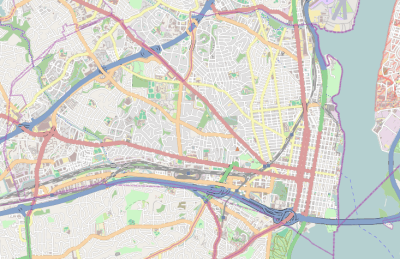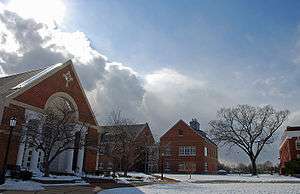Episcopal High School (Alexandria, Virginia)
| Episcopal High School | |
|---|---|
_logo.png) | |
| Location | |
 Episcopal High School  Episcopal High School  Episcopal High School  Episcopal High School | |
|
Alexandria, Virginia United States | |
| Coordinates | 38°49′28.5″N 77°5′39.9″W / 38.824583°N 77.094417°WCoordinates: 38°49′28.5″N 77°5′39.9″W / 38.824583°N 77.094417°W |
| Information | |
| Type | Private Preparatory Boarding School |
| Motto |
Fortiter, fideliter, feliciter "Strongly, faithfully, joyfully" |
| Religious affiliation(s) | Episcopal |
| Established | 1839 |
| Headmaster | Charley Stillwell |
| Enrollment |
440 faculty = 80 |
| Average class size | 11 |
| Student to teacher ratio | 6:1 |
| Campus |
City, 130 acres (.55 km²) 26 buildings |
| Color(s) | Maroon and Black |
| Athletics | 16 Interscholastic Sports |
| Athletics conference |
IAC (Boys) ISL (Girls) |
| Mascot | Maroon |
| Average SAT scores (2005) | 629 verbal, 647 math |
| Tuition | $47,850 |
| Website | www.episcopalhighschool.org |
 | |
Episcopal High School (also The High School, or Episcopal), founded in 1839, is a private boarding school located in Alexandria, Virginia. The Holy Hill 130-acre (0.53 km2) campus houses 440 students from 31 states, the District of Columbia and 16 different countries.[1] The school is 100-percent boarding and is the only all-boarding school of its caliber located in a major metropolitan area.[2]
History
Episcopal High School was founded in 1839 as the first high school in Virginia.[3] The Rev. William N. Pendleton and three assistant heads initially taught 35 boys at the boarding facility which occupied 80 acres of land. It was originally known as The Howard School, from its location at the site of an earlier school.[4] It became known affectionately as "The High School".[3] The central administration building, Hoxton House, dates to around 1805, built by Martha Washington's eldest granddaughter, Elizabeth Parke Custis Law.[5]
In 1840, Episcopal's student body tripled in size to accommodate more than 100 boys. It continued to grow until the Civil War, when it closed immediately after Federal forces occupied Alexandria in 1861. Some 500 students served as soldiers in the war, many like Rev. Pendleton (who became a Brigadier General) for the Confederacy. For the next five years, school buildings served as part of a large hospital for Federal troops. Poet Walt Whitman served as a nurse in the hospital.[5]
The school reopened in 1866. Under the direction of Launcelot Minor Blackford (Principal, 1870-1913), the school initiated a modern academic curriculum as well as pioneered interscholastic team sports in the South, including football, baseball, and track. EHS competes against Woodberry Forest School in the longest-running consecutive high-school football rivalry in the South and one of the oldest in the United States.
Beginning in 1900, every fall the Maroon and the Woodberry Forest Tigers have competed on the football field. The location of the game alternates each year; it is either in Orange or Alexandria.[6] Recognizing the need to improve its facilities, the School also undertook an aggressive building program that formed the foundation for the present-day campus.
During this era, Episcopal also instituted its Honor Code, one of the oldest among secondary schools. A committee of students and faculty members promotes understanding of the code and handles violations. The Honor Code has served as a foundation of the EHS community since its inception.
In 1991, Episcopal began a transition to coeducation by enrolling its first 48 girls, a group commonly referred to as “The First 48.” . The first coeducational class graduated in 1993. Today, the School has an enrollment of 440 students, 50 percent of whom are girls.[7]
Athletics
Episcopal fields 43 boys’ and girls’ interscholastic teams in 16 different sports: football, field hockey, soccer, tennis, cross county, volleyball, basketball, climbing, squash, track and field, wrestling, baseball, crew, golf, lacrosse, and softball. Non-interscholastic sports, such as kayaking, dance, cross training, and strength training, are also available.[8]
The boys’ teams compete in the Interstate Athletic Conference (IAC). The school has won 32 IAC Championships since 1979 and seven Virginia Independent School State Championships since 1996. Episcopal’s girls’ teams compete in the Independent School League (ISL). They have won 21 ISL Championships since 1993.[9]
In the fall of 2008 the boys' varsity soccer team completed a perfect IAC season with a 23-0-0 record.[10] It went on to become the number one team in the state of Virginia by defeating NSCAA-nationally-ranked #3 Norfolk Academy 4-0 in the VISAA Championship final. The team finished the season ranked as the #13 team in the country.[10] In the 2009 fall season the boys' varsity soccer team finished the year with a double overtime win over Collegiate School(Richmond, VA) which brought two consecutive state championship trophies back to Alexandria.[10] Episcopal was also the 2009 IAC champion and was ranked as the number 3 team in the country.[11]
There are varsity, junior varsity, and, for some sports, junior-level teams. Students are expected to complete three seasons of sports as freshmen, at least two as sophomores and juniors, and at least one as seniors. However, these requirements may be met by participation in non-interscholastic sports or by serving as managers for the scholastic sports teams.
Arts programs
Episcopal offers arts courses in instrumental music, vocal music, acting, dance, ceramics, photography, videography, drawing, painting, music theory, and music recording.[12] All students entering as freshmen are required complete one credit in the arts, and older students must complete one-half credit in order to graduate.[13]
Arts courses take place in the 42,000 square-foot Ainslie Arts Center, named for former headmaster Lee S. Ainslie ’56. The building opened in 2003 and includes a black box theater and a digital recording studio.[14]
The school regularly offers student and professional art shows, concerts and workshops. The National Chamber Players perform at the school several times each year, and student musicians often perform with the Youth Symphony Orchestra.[15]
Religion
Students are required to attend a 15–20-minute chapel service three times a week. There is a voluntary church service each Sunday, and once a month there is a mandatory vespers service on Sunday evenings. The Friday chapel service is usually student-led. Students of all religions are accepted to the school and allowed to lead Friday Services should they wish to do so. The school is informally affiliated with the Episcopal Diocese of Virginia, yet all are welcome. Often there will be a guest speaker in the chapel services. Among these speakers are former student Tim Hightower and Archbishop Desmond Tutu.[16]
Expenses
The comprehensive tuition fee for the 2016-17 school year was $54,250, in addition to the technology fee ($250), cost of books (about $700), and spending money. Student activities are included in the tuition, although there are some exceptions.[17]
Each student is also required to purchase a laptop of their choice before entering the school as part of the school’s laptop program. The computers are frequently used in the classroom.[18]
The school offers financial aid in the form of grants, based on financial need and the individual student’s merit. About 34 percent of the student body received aid for 2015-16, with a total of over $6.6 million awarded.[17]
Notable alumni
- Stephen Ailes, Secretary of the Army (1964–1965)
- Louis Bacon, hedge fund manager, Member of the Forbes 400
- Dominique Badji, Forward, Colorado Rapids
- Newton D. Baker, Secretary of War (1916–1921), Founder of Baker Hostetler
- Cass Ballenger, Republican congressman from North Carolina
- T. Berry Brazelton, pediatrician and creator of the Brazelton Neonatal Behavioral Assessment Scale
- Gaston Caperton '59, former governor of West Virginia and president of the College Board
- Danny Coale, NFL Wide Receiver, Dallas Cowboys, Indianapolis Colts
- Virginius Dabney, editor of the Richmond Times-Dispatch (1936–1969) and winner of the 1948 Pulitzer Prize for Editorial Writing
- Paul DePodesta, former GM, Los Angeles Dodgers
- Todd Gray, Chef and Owner of DC's Equinox Restaurant
- Tim Hightower, NFL Runningback, Arizona Cardinals, Washington Redskins
- James Addison Ingle, first Bishop of the Missionary District of Hankow, China
- Lester Kinsolving, Political Talk Show Host on WCBM and Member of White House Press Corps
- John McCain '54, Republican senator from Arizona and the 2008 Republican Party candidate for President of the United States[19]
- R. Walton Moore, United States House of Representatives (D-VA), (1919–1931)
- Sean Nelson, Vocals for the alternative rock group Harvey Danger
- Forrest Pritchard, New York Times bestselling author and sustainable farmer
- Arinze Onuaku, NBA forward, Orlando Magic
- Julian Robertson, financier
- Quentin Roosevelt, youngest son of Theodore Roosevelt
- Bryson Spinner, NFL QB, San Francisco 49ers
- Ernie Stires, musician and composer
- Ernest M. Stires, Episcopal Bishop of Long Island
- Robert E. L. Strider, president of Colby College (1942-1960)
- LTG Thomas J. H. Trapnell, WWII hero and Bataan Death March survivor
References
- ↑ "EHS: At a Glance". Episcopal High School website. Retrieved February 18, 2008.
- ↑ Price, Douglas C. "EHS: Admissions". Episcopal High School website. Archived from the original on December 8, 2006. Retrieved December 10, 2006.
- 1 2 "EHS: History". Episcopal High School website. Retrieved February 18, 2008.
- ↑ Kinsolving, Arthur Barksdale (1922). "The story of a southern school: the Episcopal High School of Virginia". Baltimore, Maryland: The Norman, Remington Co.: 18–21.
- 1 2 Virginia Department of Historic Resources (1997). ""Episcopal High School" marker". HMdb.org The Historical Marker Database. Retrieved March 23, 2011. External link in
|publisher=(help) - ↑ Morones, Mike (December 1, 2007). "'THE GAME': HIGH NOON For 111 years, two rival high-school football teams have squared off with one overriding goal: Sweet victory". The Free Lance-Star. Retrieved February 18, 2008.
- ↑ "EHS: At A Glance". Episcopal High School website. Retrieved August 4, 2017.
- ↑ "EHS: Sports Offerings". Episcopal High School website. Retrieved March 15, 2008.
- ↑ "EHS: Athletics Brochure". Episcopal High School website. Retrieved March 15, 2008.
- 1 2 3 "News » News Detail". Episcopal High School. December 1, 2009. Retrieved August 13, 2012.
- ↑ "High School Sports - ESPNHS". Sports.espn.go.com. Retrieved August 13, 2012.
- ↑ "EHS: Academic Offerings in the Arts". Episcopal High School website. Retrieved March 29, 2008.
- ↑ "EHS: Academics". Episcopal High School website. Retrieved March 29, 2008.
- ↑ "EHS: Episcopal At A Glance". Episcopal High School website. Retrieved March 29, 2008.
- ↑ "EHS: The Arts at Episcopal High School". Episcopal High School website. Retrieved March 29, 2008.
- ↑ EHS News: "Dream About a Better World"
- 1 2 "EHS: Tuition and Financial Aid". Episcopal High School website. Retrieved March 29, 2008.
- ↑ "EHS: Tuition and Financial Aid". Episcopal High School website. Retrieved March 29, 2008.
- ↑ McCain has repeatedly noted in speeches that his high school days, and in particular the influence of William Bee Ravenel III were an important formative influence on his life. See McCain, John S. (April 1, 2008). Episcopal Offered Me a Home Text of speech at Episcopal High School (Alexandria, Virginia). Retrieved on 2008-05-04. Also see Ringle, Ken (May 12, 2008). A Hero's Life. The Weekly Standard Volume 013, Issue 33. Retrieved on 2008-05-04
External links
- Episcopal High School's official website
- The Association of Boarding Schools profile
- Profile from BoardingSchoolReview.com
- 1938 TIME Magazine Article on Episcopal's Centennial